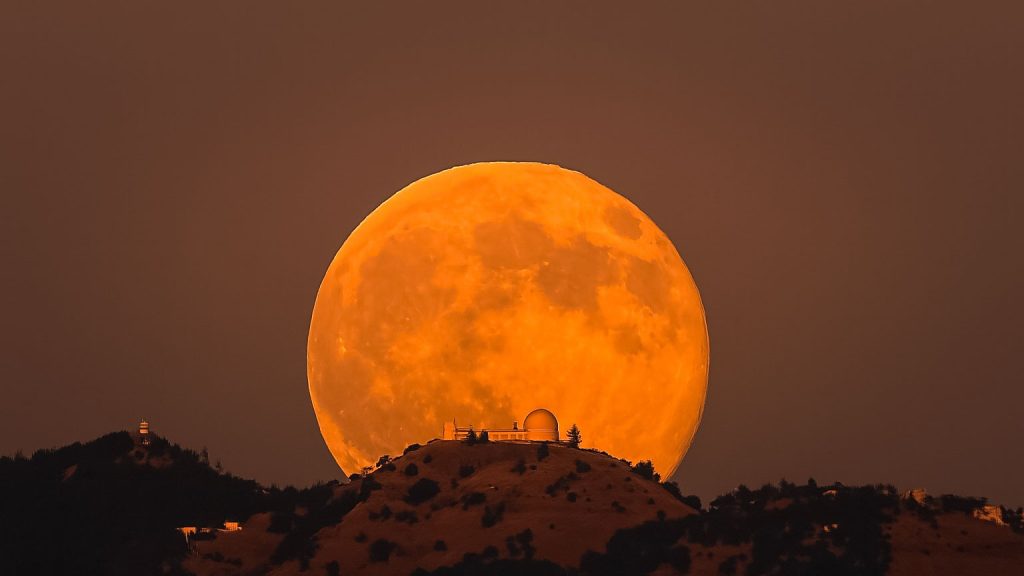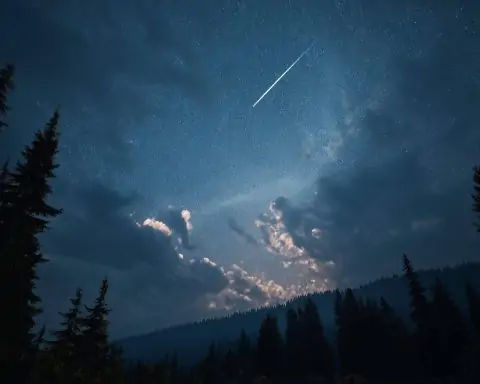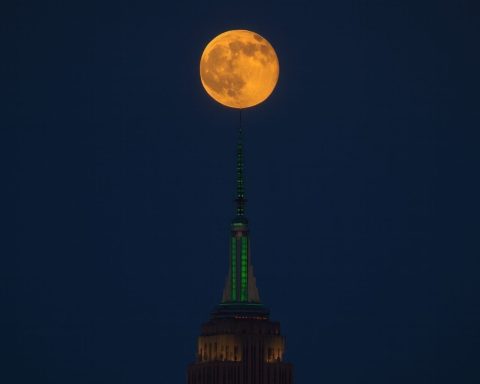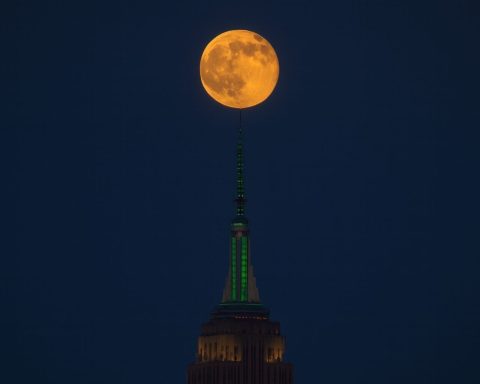- Taurid Meteor Showers: Northern and Southern Taurids ramp up in early Nov 2025. Their broad peaks (Southern Taurids ~Nov 5, Northern Taurids ~Nov 9) overlap, producing only a few meteors per hour but often bright fireballs [1] [2]. Experts warn 2025 is a Taurid “swarm” year (extra large meteoroids), so observers may see more fireballs than usual [3].
- Leonid Shower: The Leonids peak mid-month (Nov 16–17) with dark, moonless skies. Observers could see ~15 meteors/hour at peak under ideal conditions [4] [5]. While no storm is expected, the fast Leonid meteors (~70 km/s) can be spectacular if witnessed [6] [7].
- Beaver Supermoon: A full “Beaver Moon” on Nov 5, 2025 will be the brightest full moon of 2025, a supermoon ~7–8% larger than average [8] [9]. Its intense light will wash out faint meteors, severely impacting early November viewing [10] [11].
- Viewing Times & Conditions: For the best show, find very dark skies away from city lights and watch after midnight into the pre-dawn hours. Radiants of the Taurids and Leonids rise late; AMS advises that meteor rates peak in the last few hours before dawn [12] [13]. Plan for clear, moon-free nights (the moon sets late on Nov 5, giving a small dark window).
- Auroras & Space Weather: Solar activity is high in late 2025. NOAA and space-weather forecasters note that minor geomagnetic storms (G1–G2) are possible in early Nov, potentially bringing northern lights to mid-latitudes [14] [15]. Space weather (CMEs from new sunspots) will be monitored closely; even a G1 storm can yield auroras as far south as northern U.S./Europe [16] [17].
Major Meteor Showers Lighting Up Early November
Early November’s sky features long-running meteor showers rather than any single dramatic outburst. The Southern Taurids (active late Sept–Nov 12, peak ~Nov 5) and Northern Taurids (Oct 13–Dec 2, peak ~Nov 9) are joined by the annual Leonid stream (active Nov 3–Dec 2, peak Nov 17). AMS notes that these two Taurid sources and the Leonids “keep the skies active” in November, making it one of the better months for northern observers [18]. In practice, the Taurids each produce only a handful of meteors per hour under dark skies, but many are fireballs. AccuWeather meteorologist Brian Lada explains that the Taurids will “only combine for around five meteors per hour, but the ones that do streak through the sky could be spectacular” [19]. Space.com (quoting NASA’s Bill Cooke) adds that “the Taurids are rich in fireballs,” meaning any Taurid you see is likely to be bright and impressive [20].
The Southern Taurids peak on Nov 5–6, while the Northern Taurids crest around Nov 9 [21]. These showers overlap early in the month, so from Nov 1–7 you could catch Taurid meteors nearly every clear night. Unfortunately, the Beaver Moon (full Moon) on Nov 5 is the brightest of the year [22], washing out most fainter Taurid meteors [23]. In summary, skywatchers should still keep an eye out – as TAS expert Bill Cooke says, “if you see a Taurid it can be very brilliant” [24] – but be aware that moonlight will limit the count.
Following the Taurids, the Leonid meteor shower peaks on the night of Nov 16–17. No major Leonid storm is predicted for 2025 (the next one may not come until the early 2030s), but under perfect conditions the Leonids can produce about 15 meteors per hour. For example, TS2.tech reports that November 2025’s Leonid peak falls under a 9% illuminated crescent Moon, so “dark, moonless skies… could yield about 15 shooting stars per hour” [25]. (Space.com likewise lists the Leonid Zenithal Hourly Rate ~15 [26].) The Leonids are exceptionally fast (≈70 km/s) and can leave colorful trails, so even a modest display can be dramatic. Observers should plan to watch after midnight, when the Leonid radiant (in Leo) has risen high [27] [28].
Other minor showers (e.g. Orionids, Andromedids, ε-Geminids) contribute perhaps a meteor or two per hour each in early November. AMS cautions that sporadic (random) meteors will dominate – but these background meteors plus the Taurid/Leonid streams are enough to make November lively for northern observers [29] [30]. By contrast, observers south of the equator see far fewer: November is “fairly quiet” from southern latitudes [31].
Fireball Potential: Taurid “Swarm” Year
The Taurids deserve special attention for their fireball potential. These showers are linked to debris from Comet Encke, and some years (so-called Taurid swarm years) produce clusters of large meteoroids that yield extra-bright fireballs. Astronomers note that 2025 is such a swarm year, so while ordinary meteor counts remain low, Earth may encounter chunky debris. Space.com and TS2 both emphasize this: one source comments that Taurids have shown a seven-year periodicity in fireball outbursts [32]. NASA’s Bill Cooke likewise reminds skywatchers “the Taurids are rich in fireballs” [33].
In practice, this means that lucky observers on Nov 5–12 might spot very bright Taurid meteors cutting through the sky – even though the full Moon on Nov 5 will drown out most meteors. Any Taurid fireball (sometimes called a “Halloween fireball” in late October) can be spectacular. The Northern Taurids peak ~Nov 9 when the Moon will be ~83% waning, and the Southern Taurids peak ~Nov 5 under full moon [34]. TS2 and AMS warn that the bright lunar glare will “wash out many faint meteors” during these peaks [35], so fireballs will stand out. Enthusiasts should keep the sky in view on the nights of Nov 4–7 and Nov 8–11 – if a Taurid fireball appears, it could “knock your eyes out,” as Cooke puts it [36].
Beaver Moon and Other Celestial Events
The Nov 5, 2025 full Moon (Beaver Moon) is a major factor this week. Livescience and Nat Geo confirm it will be the year’s largest full moon, a supermoon occurring at perigee [37] [38]. The Moon’s added brightness (appearing ~7–8% larger and up to 16% brighter than average [39]) will flood the night sky with light. Astronomy outlets stress that such a supermoon can even cast shadows on the ground [40]. In meteor-watching terms, this means poor viewing conditions on the nights closest to Nov 5. AMS notes the waxing gibbous moon will remain above the horizon all night on Nov 5, leaving only the pre-dawn hours of Nov 6 moon-free [41]. In short, skywatchers should not expect to see many Taurid meteors on Nov 4/5.
Aside from the Moon, several planetary and minor celestial events occur around Nov 1–7. Jupiter and Saturn are prominent in the early sky (Jupiter rises late at night, Saturn post-sunset), though their light can slightly drown faint meteors near the horizon. TS2 highlights that no eclipses occur in November, and notes other events (planetary conjunctions, comet sightings) [42]. (For example, the interstellar comet 3I/ATLAS is moving outbound by late Nov, after its mid-Oct perihelion, and won’t interfere with skywatching this week.) In summary, the main “space weather” event is the supermoon; for meteor viewers, that’s more a hindrance than a spectacle.
Best Viewing Tips & Timing
To maximize your chance of seeing meteors, follow expert advice and timing:
- Go late – Taurid and Leonid radiants rise well after sunset. Experts agree that the last few hours of night (after midnight into dawn) are best for catching them [43] [44]. TS2 advises “plan to watch after midnight… from a dark location” [45].
- Find dark skies – Light pollution from cities can hide all but the brightest meteors. AMS reminds us that their quoted rates assume dark-sky sites. Even suburban skies will show far fewer meteors [46].
- Block the Moon – On nights near Nov 4–6, the Moon will be high. If it is in your sky, use a natural or artificial horizon to block it. Some skywatchers turn their backs on the Moon or hide it behind a building. This can reveal fainter meteors that would otherwise be washed out [47] [48].
- Stay out long – Allow 30 minutes for your eyes to adapt to the dark, and be patient. Meteors are random; the longer you watch, the more you’ll see. Bring a red flashlight (so your eyes stay dark-adapted) and dress warmly.
According to AMS modeling, an observer at mid-northern latitudes (∼45° N) under dark skies might see on the order of 10–12 meteors per hour in the pre-dawn on these dates (including sporadics) [49]. Southern observers (25° S) would see only about half that count [50]. Keep in mind that “visible” meteors are only those bright enough to stand out through any moonlight or haze. Bill Cooke emphasizes that Taurid meteors burn lower and slower (at ~17 mi/s) and tend to be longer-lasting in the atmosphere [51], so scanning a large swath of sky with your eyes or a wide lens camera is key.
Aurora and Space Weather Alerts
November 2025 is also a prime time for aurora watchers. Solar activity is near an 11-year peak, and any moderate coronal mass ejection (CME) could spark northern (or southern) lights. Forecasters at NOAA’s Space Weather Prediction Center note that a high-speed solar wind stream from an October 29 CME is expected to brush past Earth around Nov 2–3 [52]. This could trigger unsettled geomagnetic conditions (Kp ~2–4), with a chance of G1 (minor) storms and even brief G2 (moderate) on Nov 3 [53]. If a CME hits, multi-hour intervals of Kp=4–5 have already occurred, suggesting auroras might reach middle latitudes.
TS2.tech reports that experts consider November nights “prime aurora season” [54]. As astrophysicist Dr. Renate Mauland-Hus explains, even after solar maximum the Sun’s activity can stay strong, so any geomagnetic storm could paint green curtains far from the poles [55]. To quote TS2: “A minor G1-class storm can spark auroras visible across northern-tier U.S. states or central Europe; a stronger G2/G3 storm can push the lights even farther… Given the elevated solar activity, it’s quite possible at least one such storm will occur this month” [56].
Practical tip: anyone interested in auroras should follow NOAA/SpaceWeather alerts (e.g. NOAA’s Kp forecasts and SWPC alerts) in the week of Nov 1–7. On stormy nights, head to a clear, dark site at high latitude (Alaska, Canada, Northern Europe, or Southern Hemisphere analogues) between ~10 pm and 2 am local. Auroras often flare up a day after an X-ray or CME event on the Sun (see EarthSky reports of recent solar blasts [57]). In early Nov 2025, a 3-day NOAA forecast indeed hinted at possible glancing CME impacts around Nov 2–3 [58]. Keep a sky app or alert on standby – you might witness nature’s “Grand Fireball Show” all the way to the horizon.
Expert Commentary
Astronomers and meteor experts are excited about the early-November sky. “The Taurids are rich in fireballs,” NASA meteor specialist Bill Cooke (NASA/MSFC) tells Space.com [59]. However, he warns that their “rates absolutely suck” (only a few meteors/hour) so patience is needed [60]. AccuWeather’s Brian Lada notes that even a handful of bright Taurids can be “spectacular” [61], and he highlights the nearly full Moon’s interference: “In 2025, the full moon coincides with the start of the [Taurid] meteor showers, but some fireballs may still be visible” [62].
AMS observer Robert Lunsford (American Meteor Society) emphasizes the north-south contrast: “meteor rates continue to be strong in November… November one of the better months to view meteor activity from north of the equator” [63]. His outlook for Nov 1–7 notes that sporadic meteors will boost counts, but also warns that the full Beaver Moon will be overhead all night on Nov 5, limiting dark-sky time [64] [65].
Space weather scientists stress preparedness: NOAA SWPC forecaster Dan Biesecker (quoted in EarthSky) points out that a small CME on Oct 29 could graze Earth’s field around Nov 2 [66]. Solar physicists like C. Alex Young (NASA) remind us that new sunspot regions are emerging, so any eruption could create storms. As EarthSky notes, recent days showed minor geomagnetic unrest (with Kp reaching 5), so “continued unsettled space weather keeps aurora watchers on alert” [67].
Global Interest and Impact
Meteor showers and celestial events always draw public attention. Astronomy news sites (Space.com, EarthSky, AccuWeather) and social media are already highlighting November’s sky: search Twitter on Nov 1 and you’ll find “meteor showers 2025” trending, and amateur photographers share daily fireball videos. The AMS fireball log itself has recorded dozens of bright-fireball reports every week (recent entries list hundreds of eyewitness accounts per event [68]), indicating how eagerly people around the world look up.
In the northern hemisphere, twilight falls earlier and nights are long in November, offering extended dark periods ideal for skywatching. Many northern countries (US, Europe, Canada, Russia, etc.) will have a front-row seat to Taurids, Leonids, and any auroras. Southern-hemisphere observers (South America, South Africa, Australia/New Zealand) will see far fewer meteors (AMS notes southern rates are “much lower” [69]) but still can glimpse the brighter Taurid fireballs on clear nights. Meanwhile, space weather is truly global: a large CME could cause disruptions in satellites, GPS and radio communications worldwide. (In fact, Reuters reported that a 2024 solar storm forced SpaceX’s Starlink network into “degraded service” [70], a reminder that even consumer tech can feel solar fury.)
Overall, November 1–7, 2025 promises a bit of everything: the chase for rare meteors, the allure of a giant Moon, and the chance of seeing nature’s most dazzling lights. As one astronomer puts it, this week is an “invitation to watch the space weather” [71] – an invitation we encourage everyone to accept. So bundle up, grab your star-chart or app, head outside on clear nights, and enjoy the show. The sky is ready – are you?
Sources: American Meteor Society outlook [72] [73]; Space.com meteor guides [74] [75]; TS2.tech astronomy reports [76] [77]; AccuWeather space news [78] [79]; Livescience/NatGeo (supermoon) [80] [81]; EarthSky/NOAA forecasts [82] [83]; Reuters (Starlink storm) [84] (as context).
References
1. www.accuweather.com, 2. www.space.com, 3. ts2.tech, 4. www.accuweather.com, 5. www.space.com, 6. ts2.tech, 7. www.space.com, 8. www.livescience.com, 9. ts2.tech, 10. ts2.tech, 11. www.livescience.com, 12. www.amsmeteors.org, 13. ts2.tech, 14. earthsky.org, 15. ts2.tech, 16. ts2.tech, 17. www.reuters.com, 18. www.amsmeteors.org, 19. www.accuweather.com, 20. www.space.com, 21. ts2.tech, 22. www.livescience.com, 23. ts2.tech, 24. www.space.com, 25. ts2.tech, 26. www.space.com, 27. ts2.tech, 28. www.amsmeteors.org, 29. www.amsmeteors.org, 30. www.accuweather.com, 31. www.amsmeteors.org, 32. ts2.tech, 33. www.space.com, 34. ts2.tech, 35. ts2.tech, 36. www.space.com, 37. www.livescience.com, 38. www.nationalgeographic.com, 39. www.nationalgeographic.com, 40. www.nationalgeographic.com, 41. www.amsmeteors.org, 42. ts2.tech, 43. www.amsmeteors.org, 44. ts2.tech, 45. ts2.tech, 46. www.amsmeteors.org, 47. www.amsmeteors.org, 48. ts2.tech, 49. www.amsmeteors.org, 50. www.amsmeteors.org, 51. www.space.com, 52. earthsky.org, 53. earthsky.org, 54. ts2.tech, 55. ts2.tech, 56. ts2.tech, 57. earthsky.org, 58. earthsky.org, 59. www.space.com, 60. www.space.com, 61. www.accuweather.com, 62. www.accuweather.com, 63. www.amsmeteors.org, 64. www.amsmeteors.org, 65. www.amsmeteors.org, 66. earthsky.org, 67. ts2.tech, 68. www.amsmeteors.org, 69. www.amsmeteors.org, 70. www.reuters.com, 71. ts2.tech, 72. www.amsmeteors.org, 73. www.amsmeteors.org, 74. www.space.com, 75. www.space.com, 76. ts2.tech, 77. ts2.tech, 78. www.accuweather.com, 79. www.accuweather.com, 80. www.livescience.com, 81. www.nationalgeographic.com, 82. earthsky.org, 83. ts2.tech, 84. www.reuters.com










